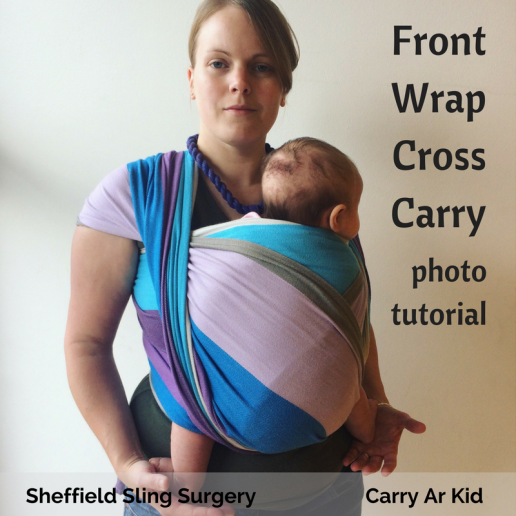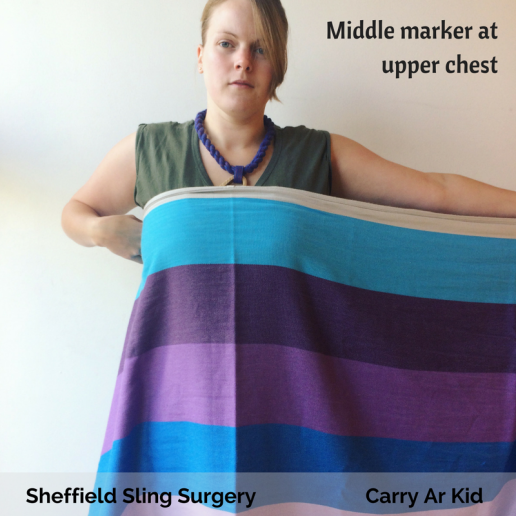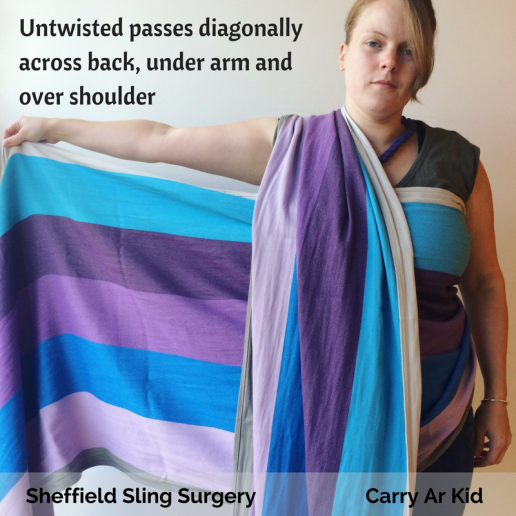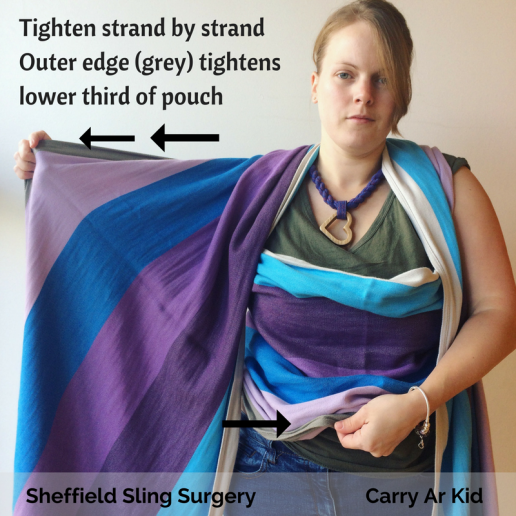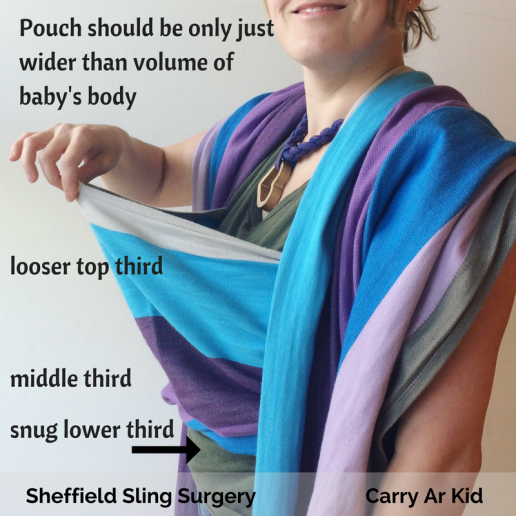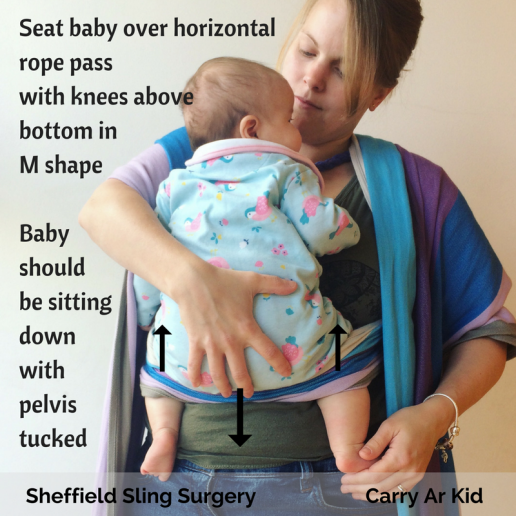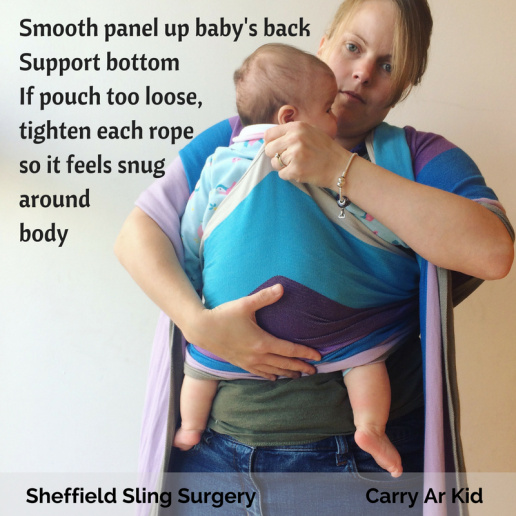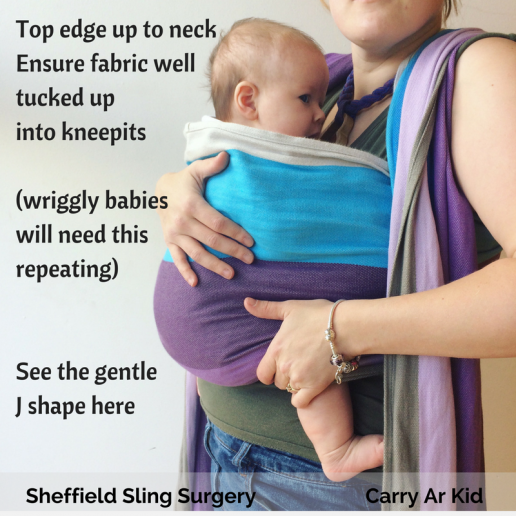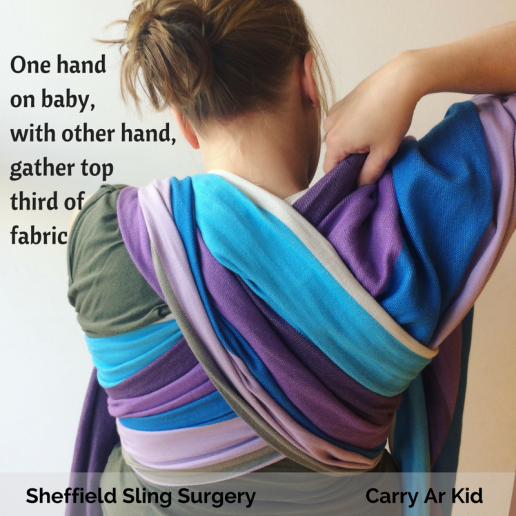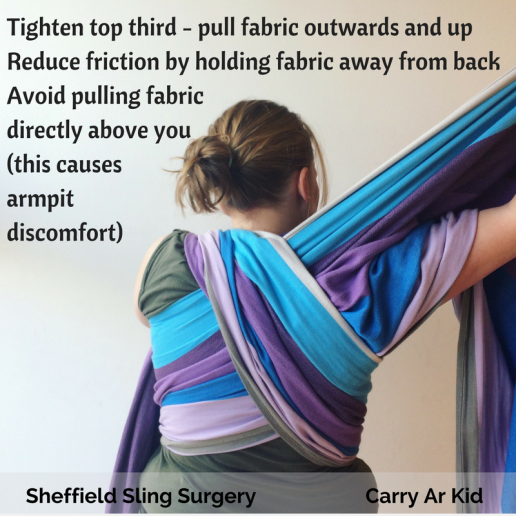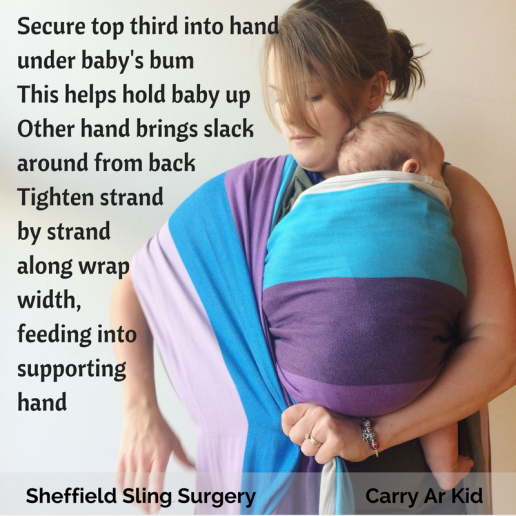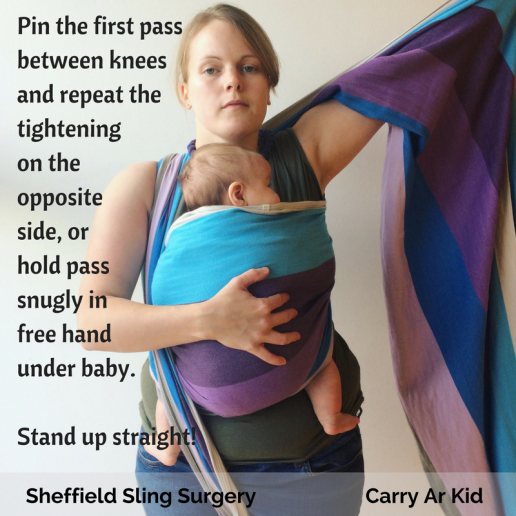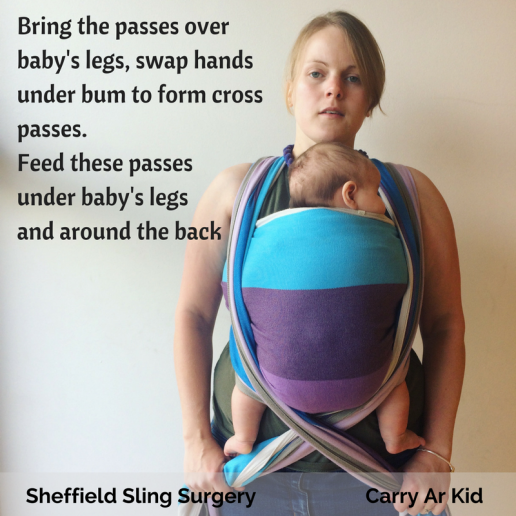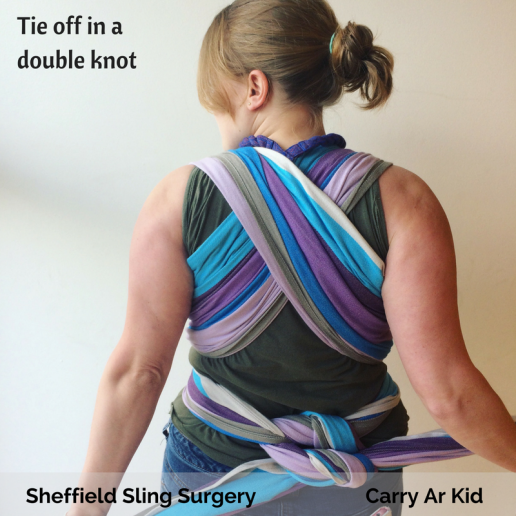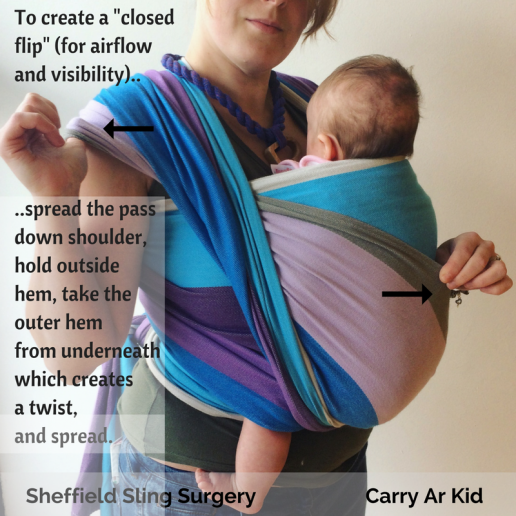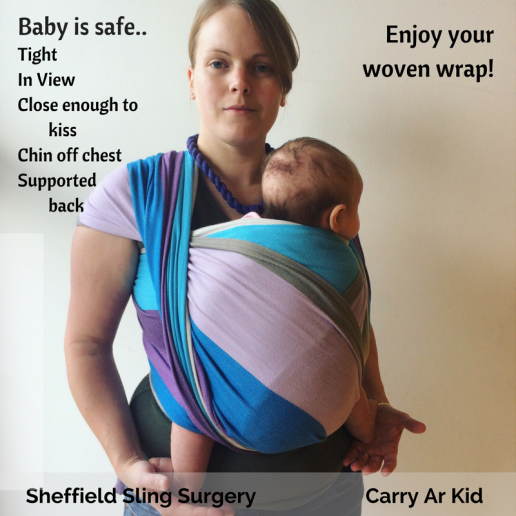Many people love woven wraps. They come in a huge range of patterns, colours and fabric types, and can be used from birth to toddlerhood and beyond. They can be very comfortable to use, due to the wide weight distribution, and one wrap can be used by more than one person without needing to adjust the height of straps or buckles, thus they can be excellent value for money. They can also be used to carry two children together!
Like all carriers, woven wraps need to be used safely and the TICKS guidelines should always be followed. The most important consideration is to protect baby’s airway; a baby’s neck should never be folded in half and two fingers should fit between their chin and their chest.
The most frequently adopted position for carrying young babies is upright and facing the parent, with legs slightly spread apart (the M position) and head well supported, as this will also protect growing hips and spine. Typically this will be the “front wrap cross carry” which is easy to learn.
Woven wraps can be tied in many, many ways and can therefore also be used for other front carries, hip or back carries as babies grow.
“It’s like a warm, blankety, all-encompassing hug, moulding to you both perfectly every time.”
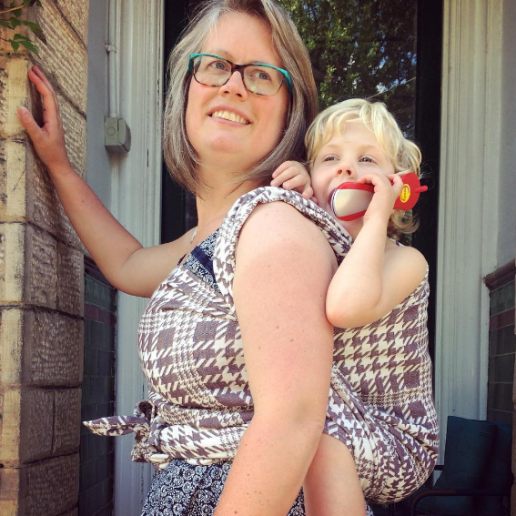
The snugness can be very useful for parents suffering from post-natal depression; that extra “wrapped-around” closeness can aid oxytocin release and assist with bonding.
Children often find great reassurance in the closeness and will often fall asleep during the process of wrapping! Wraps can also be used for creating great visibility so curious children will enjoy them just as much!
What are Woven Wraps?
Woven wraps have been part of normal family life for countless generations all around the world.
Modern woven wraps are long parallelograms of fabric that have been woven on a large loom. The loom is pre-loaded with threads that run vertically up and down (the warp) and then another set of threads (the weft), which are woven horizontally in and out of the warp threads to create patterns.
Many are still handwoven, by small communities around the world that have been using these skills for centuries. The Western market is waking up to the value of supporting such fair trade and sustainable businesses that lift people out of poverty. Some small artisan businesses make handwoven wraps one by one, it can be a very slow process!
The majority of wraps sold in the West are machine woven. Special techniques are used to ensure the wrap has a great deal of strength and durability, making them different from other woven cloths such as tablecloths or clothes. Some are pre-treated to make them super soft from first use, others come “loom-state” and need a bit of breaking in to become floppy.
Woven wraps, for many, are a very comfortable sling choice. Spreading the wide fabric around your body helps to distribute the weight of your child very well, and there is much more control over positioning and snugness (which all add to comfort levels).
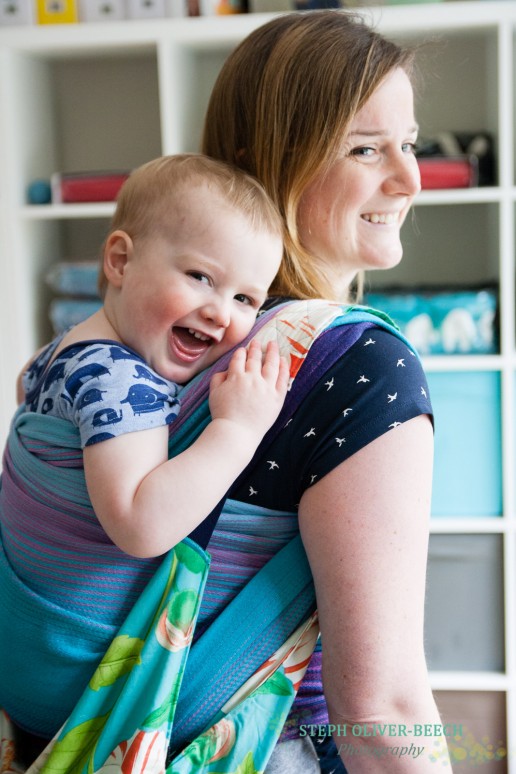
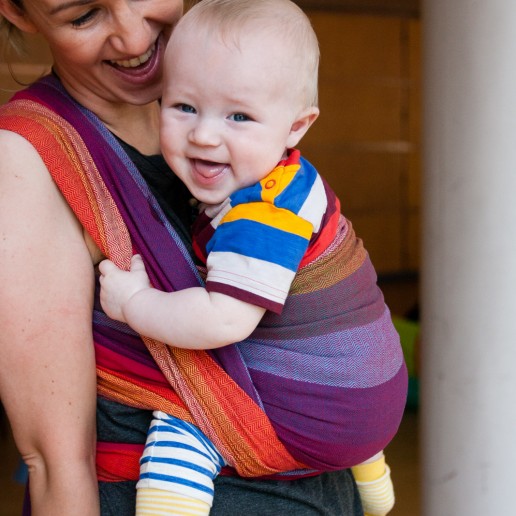
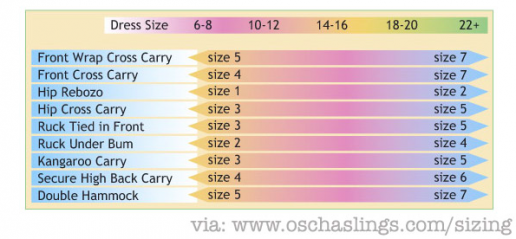
Types of Fabric
Most wraps are woven with cotton threads, as cotton is easy to care for, soft, strong and supportive. Some wraps are woven as blends of cotton with other fibres, such as wool, linen, hemp, silk or bamboo. These fibres can add features such as extra supportiveness, grippiness, softness or glide, and people will often have their preferences. Some wraps are thinner and cool to wear, some are dense and blankety for extra comfort.
Sizes of Wrap
Woven wraps come in a range of sizes which are numbered (in the same way shoe sizes are) to help people identify which length suits them best. Most people will start with the standard size 6 (4.6m) which allows most types of carry with most sizes of parent and child, and one wrap may be all you need to do every kind of carry you wish to! Larger and smaller sizes may find slightly longer or slightly shorter wraps work better.
Some families enjoy learning to use shorter sizes and being creative with the passes to make the most of the length!
“I love being able to carry my little one with the wrap, and when my big child gets tired, it is so useful to be able to carry him in it too!”
How do I put my woven wrap on?
The type of carry you choose to use can change frequently depending on the need of your child; light snuggly front carries in the early baby days, other front, hip or back carries as they grow, single layer cooler carries, multilayer carries for warmth or greater support; a woven wrap allows all these variations. Wraps work well for carrying a toddler during pregnancy, or carrying two children together, known as ‘tandem carries’.
People often ask which wrap they should begin with. We usually advise to pick something that you love the look of, and start with a cotton wrap size 6 because cotton is easy to care for and often soft to the touch and moves with ease.
Stripes or gradations can help with learning how to make the passes, avoid twisting and recognise which sections to tighten around your baby. Many good brands these days sell wraps that are already soft and ready to use from the first wash, rather than needing a lot of work to soften up (known as “breaking in”).
Many people begin with a Front Wrap Cross Carry, which is easy and supportive and can be used for all ages. The video shows you how to do a front wrap cross carry with a woven wrap with a newborn; as their hips are not ready to be spread widely, the “lexi twist” is helpful to keep them in the narrower M shape.
As baby grows, the more standard Front Wrap Cross Carry with various extra passes is a well-loved option.
Learning how to use a wrap does take a little practice. Some parents find it comes easily and have taught themselves. Others need a few goes to get it right and find a consultation or workshop with their local sling educator where they are taught in person helpful.
With premature or especially small babies you may find it helpful to have some help in person. Your local UK sling educators can be found listed on Sling Pages.
Please note that horizontal cradle style carries are no longer recommended due to airway risk.
Front Wrap Cross Carry with a Lexi Twist (for newborns)
Lexi twist with a 4 day old
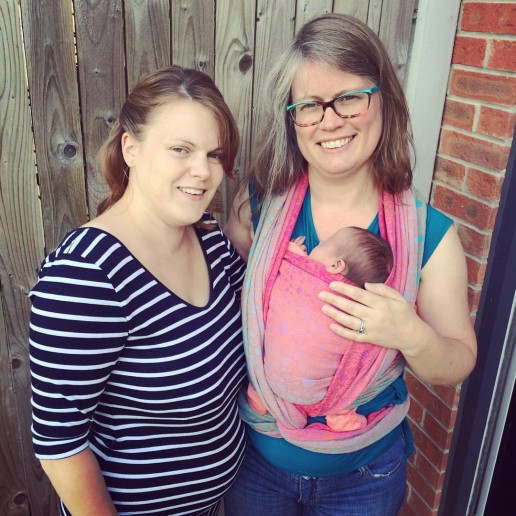
Here is a photo tutorial for a Front Wrap Cross Carry with an older baby. Please click/swipe through each image.
Here is a separate link to the photo tutorial.
Arms out / arms in
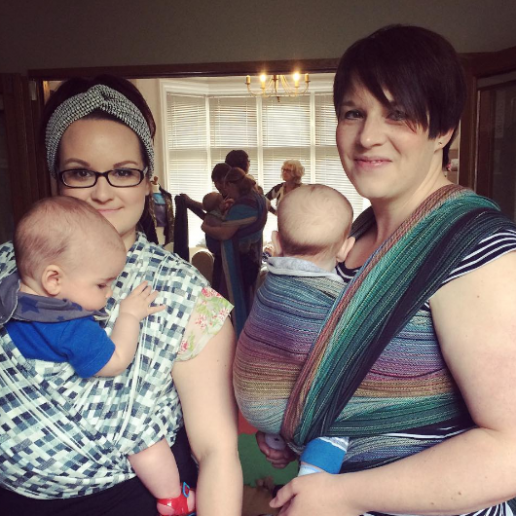
Shoulders folded out for free airflow
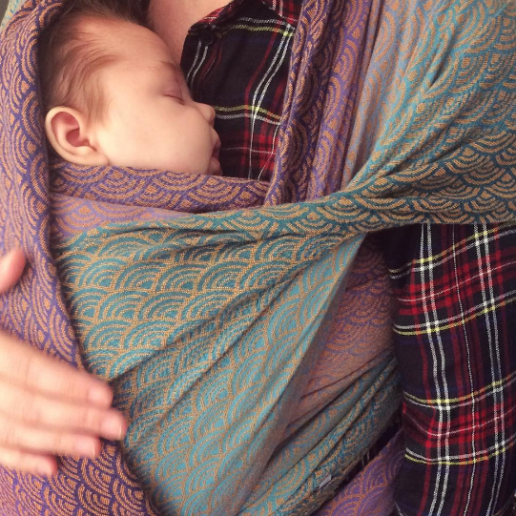
Top Tips!
- Practice tightening the fabric strand by strand. This is key for ensuring the top, middle and bottom sections of the wrap are snug around you and your baby.
- Prepare the pouch for your baby; a little snugger at the bottom third to help hold knees up, and the middle and top sections only just wider than the volume of your baby's body, so it is snug as you pull it up.
- Hold your baby straight in the centre of your chest and bring his legs through the rope pass on the front.
- Make sure he is sitting in the M shape and hold his chest close to you as you go.
- Wrap arms in if possible, and bring older babies' arms out later, once the carry is finished. Toddlers may prefer being wrapped arms out.
- Hold each tightened pass snug, or pin it between your knees as you do the other side.
- Try to stand straight whilst you are wrapping. If you lean backwards or to one side you will find the wrap is not tight or that your baby is leaning inside the carrier.
- The top and middle thirds need to be snug to avoid slumping.
- If you find any slack while wrapping, remove it.
- Ensure there is no fabric over your baby's face; you can fold the fabric out of the way, down your shoulder.
“The effort is worth it for me because being unable to breastfeed left me worried I would struggle to bond. Wrapping gives me precious bonding and closeness, and gives my daughter the ability to experience the world from a position of total security. It makes us feel like a team.”
Common Queries about Woven Wraps
Feeding in Wovens
Feeding is possible in woven wraps, with a little care to ensure baby’s airway is well protected. Typically, for breastfeeding, this involves loosening the wrap in stages so baby is lowered gently to the nipple. No breastfeeding is hands free, and it is usually a good idea to get some help and advice from people who are familiar with how to do it. Please note that when baby has finished feeding, he must be returned to his safe snug upright position, close enough to kiss.
You can read more about how to breast and bottle feed here.
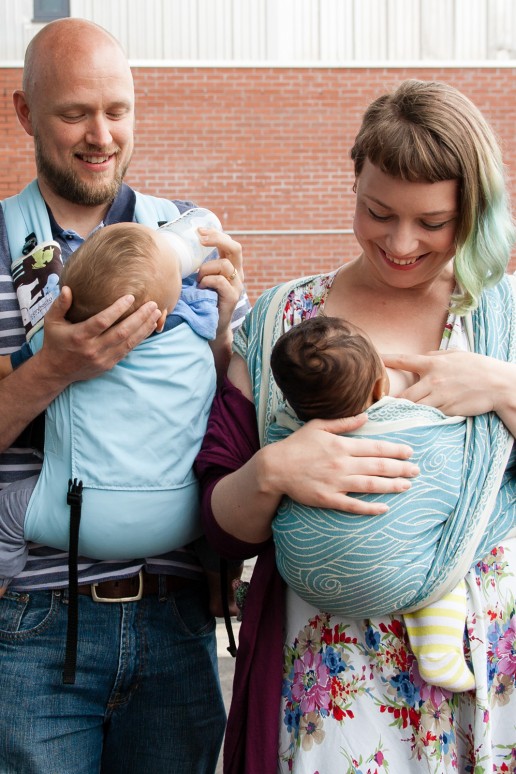
When can I start hip and back carries?
Babies can be carried “off centre” on the front from early on, as long as their natural tucked narrower M shape position is preserved. Lateral hip carries tend to work best when babies begin to sit comfortably the parent’s side, this is typically about 3 months or when baby begins to roll.
Woven wraps are so very mouldable, strand by strand, that some confident sling users will begin wrapping their babies of a few weeks old on their backs. They know they can ensure a good head, neck, back and hip support and keep baby high up to feel their breathing on their necks. It can be hard to do well and is an advanced skill.
As babies get older, back wrapping becomes easier to do, until they become wriggly! The more practice you get, the more confident you will feel, and your baby will feel more secure. There are some excellent video tutorials online such as those by Wrap you in Love, but sometimes getting some help from a professional can make it all much easier!
Read more here about beginning to back carry.
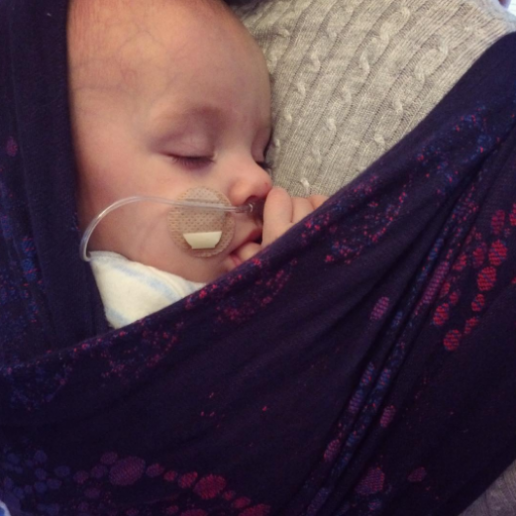
Can I carry both my children in a wrap?
Woven wraps are fantastic for carrying twins, or a combination of baby and toddler! Little ones can be carried together on the front in a single wrap, for example.
Many areas have twin and multiples support groups; it would be worth getting in touch with them, and asking your local sling educators if they can help you too!
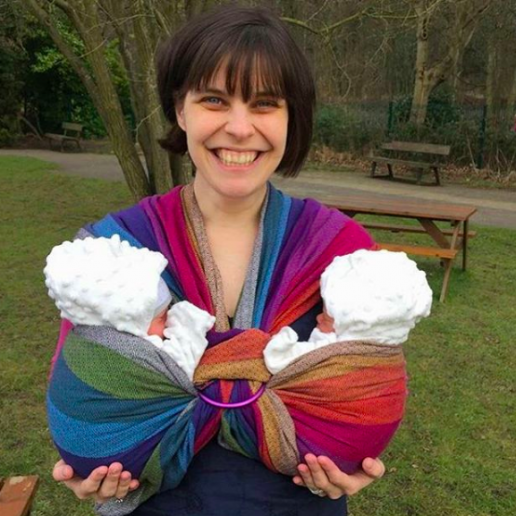
Troubleshooting your Woven Wrap
- Carry feeling too loose or too low? You are likely to have not quite got all the slack out as you wrapped at the beginning. Quite often you can untie the knot at the back and, while supporting your baby, bring each pass back to the front. Retighten each pass and tie off again.
- Baby folding over or slumping over to one side? This is likely to be looseness in the middle third; leading to an unsupported back.
- Baby's head leaning back? This is usually due to looseness of the top third of the pouch not keeping shoulders and upper body held chest to chest. This can be quickly and temporarily fixed by feeding the slack of the top third around the side and up over your shoulders, and then twisted into the side cross passes.
- Baby's face buried in fabric? Ensure the middle third is snug (looseness leads to slumping over. You can fold the shoulder passes out for airflow and visibility, and use the other side as a hood if tolerated.
- Baby wants to see the world? You can learn to flip the cross passes across baby's body for visibility.
- Baby feeling heavy? Spread the cross passes across baby's bottom from knee pit to knee pit to add extra lift.This can be done in a flipped fashion to ensure visibility too.
- Shoulder passes digging near your neck? Spread the fabric broadly across your shoulders to redistribute weight.
- Red marks at back of baby's neck? This is usually due to over tightening of the top hem of the pouch; it is the top third that needs to be snug to support the shoulders.
- Baby leg straightening? Ensure you have positioned the cross passes in the knee pits in the M shape with knees above bottom, and that these passes are snug to maintain position. You can also learn how to do some alternative carries that have early under leg cross passes (such as the front cross carry).
Shoulder spread
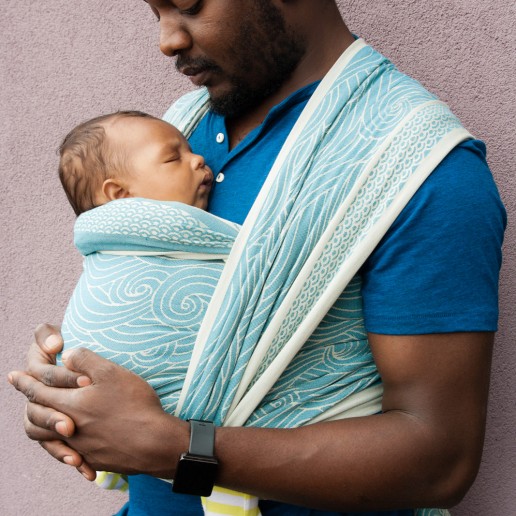
Left side "open flip"/ right side "closed flip"
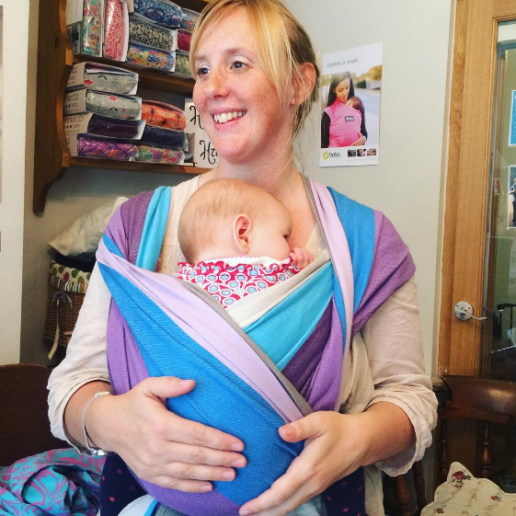
If you need some more support, your local sling educator can be found listed on then Sling Pages.


